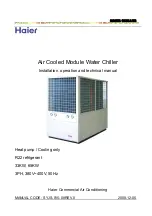
Page 19
7.2
WATER TREATMENT
Before putting the unit into operation, clean the hydraulic circuit. Dirt, scales, corrosion residue and other
extraneous material can accumulate inside the heat exchanger and reduce its heat exchanging capacity.
Pressure drops can increase, as well, thus reducing water flow. Proper water treatment therefore reduces the
risk of corrosion, erosion, scaling, etc. The most appropriate water treatment must be determined locally,
according to the type of system and to the local characteristics of the process water.
Trane is not responsible for damage to or malfunctioning of the equipment caused by failure to treat water or by improperly
treated water
Table - Acceptable water quality limits
PH (25°C)
6,8÷8,0
Total Hardness
(mg CaCO3 / l) < 200
Electrical conductivity
S/cm (25°C)
< 800
Iron (mg Fe / l)
< 1.0
Chloride ion
(mg Cl - / l)
< 200
Sulfur ion
(mg S2- / l)
None
Sulphate ion
(mg SO24- / l)
< 200
Ammonium ion
(mg NH4+ / l)
< 1.0
Alkalinity
(mg CaCO3 / l)
< 100
Silica
(mg SiO2 / l)
< 50
7.3
WINTER FREEZE PROTECTION ON THE EVAPORATOR EXCHANGER
Two or more protection methods should be foreseen when designing the system as a whole:
1. Continuous water flow circulation inside piping and exchanger when ambient air temperature is
holding below 5 °C. This implies what follows:
- if the water flow inside piping and exchanger of the unit is due to an external pump installed by the
customer, the on/off command of this pump must always be the one provided by the unit controller
through the relevant free potential contact in the electrical cabinet.
- as long as the ambient air temperature is holding below 5 °C the unit must always be electrically
supplied. Moreover the customer pump, if present, must always be electrically supplied alike and
functioning properly.
2. Addition of an appropriate amount of glycol inside the water circuit.
3. Additional heat insulation and sufficient heating of exposed piping.
IMPORTANT: Trane can provide various optional kits called for the protection of all the
components of the hydraulic circuit inside the unit (pumps, pipes and tank). If you want to buy
any please contact Trane .
4. Emptying and cleaning of the heat exchanger during the winter season.
It is the responsibility of the installer and/or of local maintenance personnel to ensure two or more of the
described antifreeze methods. Continuously verify, through routine checks, that appropriate anti-freeze
protection is maintained.
Failure to follow the instructions above could result in damage to some of the unit’s components. Damage from
freezing is not covered by the warranty.
CAUTION
: The unit water pipes are not protected against the risk of water freeze-up when the unit is not
electrically powered and when the power and control of the external water pump is not managed by the CCUF
unit controller. The owner or local maintenance personnel must provide appropriate solutions to prevent
freezing.
CAUTION
: A power loss of 15 minutes during freezing can damage the evaporator.
Summary of Contents for CCUF
Page 26: ...Page 26 USER SIDE...
Page 28: ...Page 28 USER SIDE...
















































